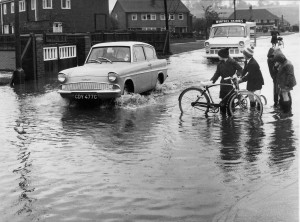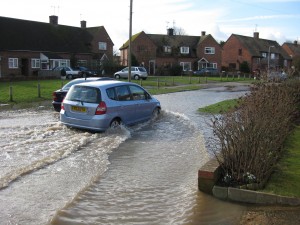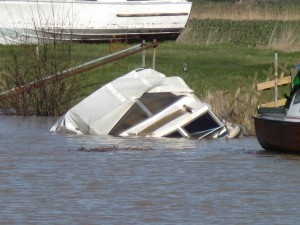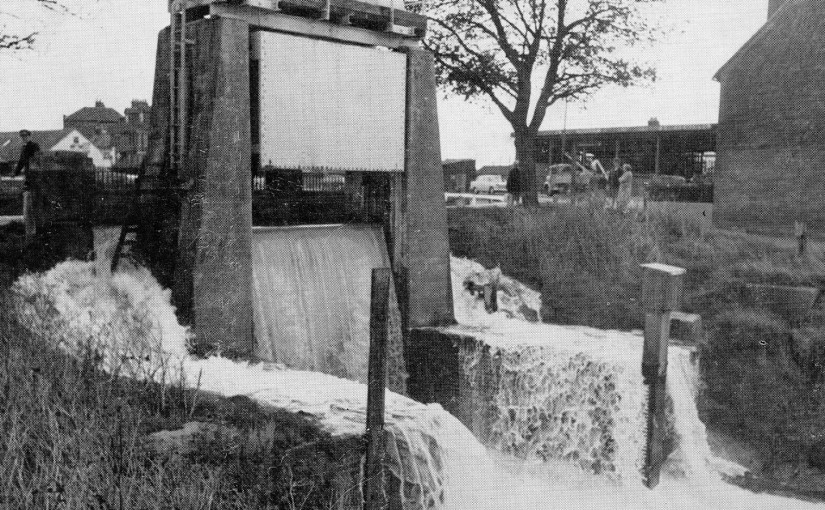From Rye’s Own April 2010
By Jim Hollands
The water has gone but the message is clear, serious flooding in Rye is not a probability any more, it’s almost a certainty.
How can I say this in the face of the ‘experts’ presentation of mind boggling facts and figures that were put forward at the recent public inquiry when the plans were given the go ahead to build 135 dwellings in the field behind Udimore Road? I lived on Tilling Green and later at Ashenden Avenue and have first hand experience of events fifty years ago when every heavy downpour produced flooding up to two feet deep in the Mason Road, Marley Road area. (This was a long time before ‘Global Warming’)

Underground tanks and a pumping station were installed to deal with the excess water, this system usually worked for Mason Road but flooding continued in The Link on a regular basis, often several times a year. No water has penetrated the houses to date but it can only be a matter of time before this happens, unless something is done to alleviate the situation. Building 135 dwellings on the hill is certainly not the answer, whatever steps are taken with water holding drains and lakes.
Draining extra surface water into the Tillingham is not possible, for when the river is full in the wet periods, its height automatically closes the doors on the drains and prevents extra water from entering until such times as the tide goes down and allows the Sluice at Winchelsea Road to be raised.
When the doors are closed the drains fill up and soon flood the roads.

There have been occasions in the past when freak high tides have overflowed the sluice gate causing a spectacular waterfall to cascade into the Tillingham. Fortunately, one of these freak tides has never come along at a time when the river was full.
Had the housing complex behind Udimore Road been completed by March of this year, as was the original idea, houses on Tilling Green and far beyond would have almost certainly been flooded when the pumping station and underground tanks were found wanting. These were installed 30 years ago to cope with a ‘hundred year storm’ but have failed to cope with a few days heavy rain.
There is a third danger, the banks of the Tillingham protecting the estate from river water are not high enough. In the past the river was dredged, increasing its capacity and the mud was scraped up on to the banks giving a few more inches of height. This practice was stopped when the Rother was found to be toxic and silt had to be carted off and disposed of at registered sites where the contamination could be dealt with. This made dredging so expensive that none was carried out for 15 or so years. Now a new system of sucking the silt off the river bed and releasing it into an outgoing tide has been deemed safe. This is fine from the mouth of the river to the Winchelsea Road Sluice but as the dredger / sucker is unable to get through to the Tillingham it cannot help clean out the section of river bordering the estate.
People who have lived and grown up in Rye understand what I am saying. I had the feeling, throughout the protests, debates and enquiry into the building of these houses, that the result was a foregone conclusion. The affair seemed to have been already decided, no matter what reasonable arguments were put forward, pointing out the danger to the people living below the proposed development.

Now the plans have been passed it seems there is nothing more to do but wait and hope that the weather is kind for the foreseeable future. The Rother east of the Iden Lock was very high and boats not moored properly were pulled under by their mooring ropes. This amount of water is not unusual here but any more draining and banking of flood plains up river could alter the situation in years to come. This will no doubt happen if planning is left to outsiders. Area Committees would mean control returning locally but are our Town Councillors ready to change course and set things in motion that will bring power back to Rye and the villages?
